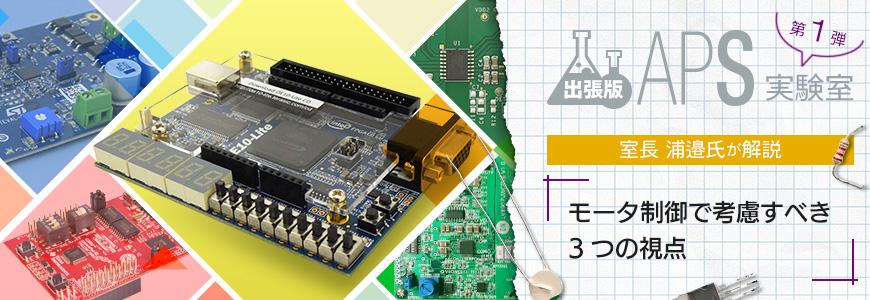Vital points of motor control Three viewpoints that should be kept in mind: "Simple," "Customized," and "The right person in the right place."
Among the various electronic device application fields, applications using motors are probably the most widely used. There are many types of motors, and the range of power that can be handled is wide, from ultra-compact precision motors to motors used in toys, brushless motors used in white goods, automobile motors, and power generation turbines, so a configuration compatible with each type is required. Masu. Some applications using motors are easy to implement, while others pose challenging demands. Motor control can be said to be a profound technology.
One of the areas of interest for motors is robotics, including drones. The motors required in robotics are different from those in previous application fields. It is "fast", "accurate", and "power saving". Depending on the target robot, "strength" may also be required.
This time, from among Macnica 's extensive lineup, we have picked up products from six vendors who are developing motor control solutions, and we have selected products from six vendors that are developing motor control solutions, and how to use them depending on the application.
- Simple
- customization
- right person in the right place
Let me tell you the key to choosing from these three perspectives.
get started easily
When it comes to motor control, if you are dealing with a motor for the first time, what should you do? When I wondered, I would like to choose whether there is a "setting tool" by PC.
If you have a dedicated GUI tool, you can turn the motor even if you don't understand it. It's also an engineer's taste to actually turn around and dig deeper from there before studying thoroughly.
Here, we have picked up three vendors that have dedicated tools that are provided free of charge. Some of them include a development environment, so I would like you to choose according to your taste and level.
Texas Instruments' integrated solution "InstaSPIN™"
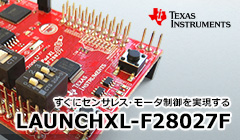
InstaSPIN™ is an integrated solution that covers a wide range of engineers from first-time motor control engineers to veteran engineers. The target MCU corresponds to the company's products.
With this solution, you can quickly spin a brushless DC motor without looking at the motor's datasheet for easy motor control. In addition, since it is equipped with a function to automatically grasp the motor characteristics, even engineers with little expertise can grasp the characteristics of the motor in a short time.
Click here for details
LAUNCHXL-F28027F realizes sensorless motor control in just 5 minutes
Infineon's "MCE Designer"
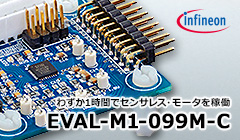
MCE Designer (free GUI tool) requires a little motor knowledge. If anything, it can be said that it is suitable for engineers who have to make new motors in the future, so it is premised that they have some understanding of the characteristics of motors. However, once the parameters are entered, surprisingly smooth FOC control is realized. Infineon's strength is that it can be "quietly", "smoothly" and "strongly".
Of course, you can write the set code to a controller dedicated to motor control and operate the motor with the same software quality.
Click here for details
What is the Modular Application Design Kit (MADK) that can run a motor with sensorless FOC control in just one hour?
OnSemiconductor's "dedicated GUI tool"
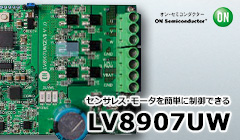
OnSemi's dedicated GUI tool is GUI-based software that can evaluate motor parameters and settings via an onboard microcomputer. Although the board itself is equipped with a microcomputer, it is operated via this GUI, so there is no need to prepare a dedicated program. In that sense, even if you are not a software engineer, you can easily operate the system. It's a great mechanism for motor control beginners.
Click here for details
LV8907UWGEVK evaluation kit for easy control of 3-phase brushless DC motors
Customize to your specifications!
It would not be an exaggeration to say that motor control demonstrates its performance by optimizing it for the application. I want to tune thoroughly without relying only on tools. For such engineers, it is very important whether the library is provided or not.
It is no exaggeration to say that the presence or absence of libraries is the key to successful development, not to mention the familiar CPU, especially when the CPU is specified.
Here, we have picked up three vendors that have abundant libraries.
Analog Devices "High End MCU Solution"
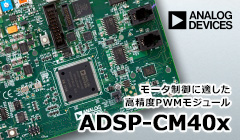
ADI's high-end microcomputer ADSZ-CM408 is equipped with a high-end microcomputer that can operate at 240MHz among Arm® Cortex®-M4. Faster processing is advantageous for motor control, but power consumption is also a concern. It is one of the few microcomputers that can clear such problems.
Although there are no dedicated tools, there are plenty of PWM libraries required for motor control. It is reassuring to be able to handle processing other than motors with ease when building applications.
Click here for details
"ADSP-CM408F EZ-KIT" evaluation board to start motor control development immediately
"FPGA MAX® 10" with built-in Intel Corporation flash
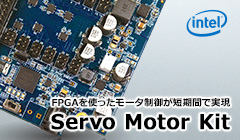
FPGA is the pinnacle of customization.
Software processing that the CPU cannot keep up with can also be processed in hardware. Servo Motor's evaluation kit supports a solution that combines the convenience of a microcontroller with the flexibility of an FPGA. The FPGA evaluation kit uses the well-established "DE10 Lite" using MAX®10.
FPGAs with built-in flash are not only flexible, but also have excellent security because both hardware and software can be stored inside the device.
Learn more about the FPGA platform and Servo Motor Kit
Motor control starting with Intel® FPGA. What is a ready-to-use FPGA development kit?
Texas Instruments "LAUNCHXL-F28027F"
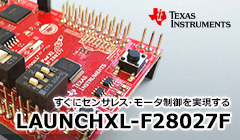
LAUNCHXL-F28027F is a real-time microcontroller product based on TI's C2000 MCU. It has a built-in 32-bit C28x™ DSP core, which makes it suitable for real-time control anyway.
Libraries are provided as well as an integrated development environment. TI's strength is that it can be used in combination with InstaSPIN to build the desired application in the shortest possible time.
Click here for details on LAUNCHXL-F28027F
LAUNCHXL-F28027F realizes sensorless motor control in just 5 minutes
Utilize the performance of the motor with the right driver for the right job!
Now let's think about a driver that matches the motor we're using.
The main types of motors are brushed DC motors, brushless DC motors, AC motors, servo motors, and stepping motors. In the case of robotics, servo motors are used for detailed movements, and brushed DC motors and brushless DC motors are used where power is required. Stepping motors are also essential for precise positioning. Motors for drones must have small inductors, be compact, and rotate at high speed. Motor rotation control is essential for attitude control in combination with sensors.
In this way, motors can be used in a wide variety of ways, so it is necessary to combine drivers that are suitable for each.
Of course, the motor drivers introduced here are all built-in protection circuits. Among electronic circuits, motor circuits tend to require relatively high power. Safety measures are also part of the design. Find the perfect combination.
Here, we introduce the lineup of motor drivers that support brushed DC motors, brushless motors, and servo motors.
Multi-channel "servo motor solution" with Intel® FPGA
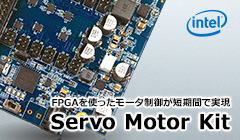
TERASIC's "DE10 Lite Servo Motor Kit" with Intel® FPGA is a Servo Motor Kit that makes use of FPGA functions.
Normally, if you want to keep outputting PWM pulses, you can use the peripheral function of the microcontroller, but by continuing to generate signals in hardware, you can minimize the burden on software. This is probably the best combination for robotics, which requires real-time performance.
Learn more about the DE10 Lite and Servo Motor Kit
Motor control starting with Intel® FPGA. What is a ready-to-use FPGA development kit?
Analog Devices' IGBT-equipped brushless motor driver "ADUM4135EBZ"
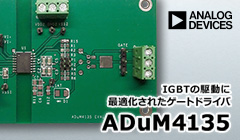
ADI's motor driver "ADUM4135EBZ" has an IGBT and an isolation circuit in the I/F section. This driver is ideal for drive systems that are resistant to noise and require high reliability.
Learn more about ADUM4135
What is the Analog Devices EVAL-ADUM4135EBZ for Reliable Industrial Motor Control?
OnSemiconductor's automotive brushless motor driver "LV8907UWGEVK"
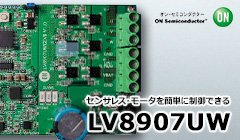
We introduced that the LV8907UWGEVK does not require a microcomputer, but it is also characterized by its compatibility with many types of motors.
When cost is required even in robotics, it is sometimes necessary to devise circuits and build with inexpensive motors. In such a case, the company's solution power will be demonstrated. It supports a wide range of voltages and enables immediate evaluation of sensorless 3-phase brushless DC motors. This is a solution that we can confidently respond to in-vehicle related applications.
Click here for details of LV8907UWGEVK
LV8907UWGEVK evaluation kit for easy control of 3-phase brushless DC motors
Infineon's brushless motor driver "inverter board" for white goods and drones
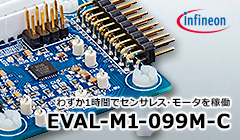
Infineon's "inverter board" is used by connecting IRMCK-M1-099M-C and MCE Tool. If it is a brushless motor, it is compatible with most motors, so we can provide it as a one-stop shop.
In addition, the inverter board covers a wide range from DC12V to 600V, so you can choose the best combination according to your application. It is characterized by being able to move everything from white goods motors to drone motors.
Click here for details of iMOTION's inverter board
What is the Modular Application Design Kit (MADK) that can run a motor with sensorless FOC control in just one hour?
Rohm brushed DC motor driver "BA6951FS-E2"
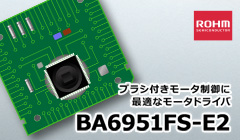
Motors are not just brushless motors. Brushed motors may have more applications in terms of the number of applications.
Rohm's brushed DC motor driver "BA6951FS-E2" supports such brushed DC motors. In addition to being inexpensive, it has the optimum configuration for applications that move at a constant speed. Of course, it also has a protection circuit.
Click here for details of BA6951FS-E2
Motor driver IC for brushed motor with speed control function BA6951FS-E2
Texas Instruments' brushed DC motor driver "DRV8870"
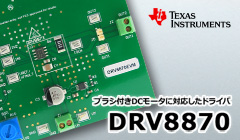
TI's brushed motor driver "DRV8870" features an ultra-small package. At just 4.9 x 6.0 mm, it has all the necessary features for driving brushed DC motors, as well as protection circuitry. If you combine it with a TI microcontroller, you can easily set it from InstaSPIN.
In addition, since it can be used not only with TI microcontrollers but also with other MCUs, it is the most suitable motor driver for applications that require miniaturization.
Learn more about DRV8870
Motor driver evaluation module "DRV8870EVM" for immediate evaluation of brushed DC motors
Summary
Now that we have introduced you to our recommended motor control solutions, what do you think?
The world of motors is deep, but the barriers are getting lower. By determining which motor to use for what kind of application, you can build the application with the help of tools and libraries. Motor control that can be used in various situations, not limited to robotics.
Why don't you take this opportunity to touch a little bit on the latest solutions? I hope that more powerful tools will come out in the future.
Click here for recommended articles/materials
Types of Sensors Required for Industrial Robots [Business Trip APS Laboratory]
| APS Laboratory [Head] Yasuo Urabe |

1995 Engaged in the development of in-house products at a semiconductor trading company
2001 Engaged in a wide range of tasks as FAE for Ethernet products at SMSC (now Microchip)
2010 Joined Altera (currently Intel) and engaged in FPGA FAE
2011 In embedded system RTOS (eForce), OS sales and consulting as sales technology
Since 2015, he is currently the head of the APS Laboratory.
We provide a wide variety of contents such as hardware, software, digital, analog, communication, and power supply in an easy-to-understand manner from an engineer's perspective.
book
Contributed articles on Mbed and Cortex-M cores, focusing on Ethernet, for CQ Publishing

